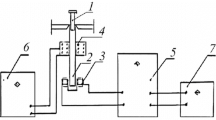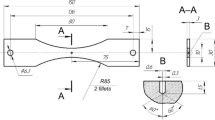Abstract
A mechanical model of fatigue crack propagation was studied. It is hypothesized that propagation is caused by cumulative damage due to strain cycling of the material at a crack tip. With Miner's cumulative damage law and Manson and Coffin's strain cycle fatigue: law, crack propagation rate of a material can be calculated. The calculated values are compared with data on 7075-T6 Al, 2024-T4 Al, AM 350 stainless steel, and 18 Ni maraging steel. The calculated and experimental values correlate reasonably well. The results indicate that fatigue crack propagation resistance of a material is related to its capability to sustain strain cycling, i.e. its cyclic ductility.
Résumé
Un modelé mécanique de la propagation des fractures de fatigue a été étudié. On suppose que la propagation provient l'accumulation des défauts en tête de la fissure durant la déformation alternée du matériau. On peut calculer la vitesse de propagation des fractures d'un matérial donné à l'aide de la loi de l'accumulation des défauts de Miner et de la loi de Manson et Coffin sur la fatigue en déformation alternée. On compare les valeurs calculées avec les résultats obtenus avec les aciers inoxydables 7075-T6 Al, 2024-T4 Al AM 350 et l'acier martensitique vieilli 18 Ni.
La correlation entre les valeurs calculées et expérimentales est assez bonne. Les résultats obtenus montrent que la résistance d'un matériau à la propagation des fractures de fatigue depend de sa capacité à soutenir les déformations alternées, c'est-à-dire de sa ductilité en déformation cyclique.
Zusammenfassung
Ein mechanisches Modell der Rißfortpflanzung in Ermüdung wurde untersucht. Es wird angenommen, daß Rißfortpflanzung durch einen akkumulierten Schädigungsprozeß, zufolge der Dehnungsschwingungen des Materials am Rißgrund, verursacht wird. Die Rißfortpflanzungsgeschwindigkeit cities Materials kann, mit Hilfe des Schädigungsgesetzes von Miner und des Manson-Coffin Gesetzes für Ermüdung durch Dehnungsschwingungen, berechnet werden. Die so errechneten Werte werden mit den experimentellen Ergebnissen für Aluminium Legierungen 7075-T6, 2024-T4, rostfreiem Stahl AM 350 und Marageing Stahl 18% Ni verglichen. Die Übereinstimmung zwischen experimentellen und errechneten Werten ist verhältnismßig gut. Die Ergebnisse zeigen, daß der Widerstand eines Werstoffes gegen Rißfortpflanzung in Ermüdung mit seiner Dehnungschwingungsfestigkeit, d.h. mit seinem dynamischen Dehnungsvermögen im Zusammenlrang steht.
Similar content being viewed by others
References
A. K. Head, Phil. Mag., 44 (1953) 7, 925.
W. Weibull, The Propagation of Fatigue Cracks in Light-Alloy Plates, Saab Aircraft Co., TN 25, Linkoping, Sweden (1954).
A. J. McEvily, Jr. and W. Illg, The Rate of Fatigue-Crack Propagation in Two Aluminum Alloys, Natl. Adv. Comm. Aero., TN 4394 (Sept. 1958).
N. D. Frost and D. S. Dugdale, J. Mech. & Phys. Sol., 6 (1958) 2.
H. W. Liu, J. Basic Engr., 83D (1961) 23–31.
P. C. Paris, M. P. Gomez and W. E. Anderson, A Rational Analytic Theory of Fatigue, The Trend in Engineering, University of Washington (1961).
V. Weiss and J. Sessler, Strain Controlled Fatigue in Pressure Vessel Materials, Winter Annual ASME Meeting (Nov. 1963).
H. W. Liu, J. Basic Engr., (March 1963).
H. W. Liu, Appl. Matls. Res., (Oct. 1964).
P. C. Paris and F. Erdogan, J. Basic Engr., (1963).
P. C. Paris, Fatigue—An Interdisciplinary Approach, eds. J. J. Burke, N. L. Reed and V. Weiss, Syracuse Univ. Press (1964).
F. A. McClintock, Fracture in Solids, Interscience, New York (1963).
J. Rice, Proc. 1st Inter. Conf. Frac., Sendai (1965).
A. J. McEvily, Jr. and T. L. Johnston, Proc. Ist Inter. Conf. Frac., Sendai (1965).
J. M. Krafft, Trans. ASM, 58 (1965) 691–695.
R. C. Forman, V. E. Kearney and R. M. Engle, “Numerical Analysis of Crack Propagation in Cyclic-Loaded Structure,” ASME Paper No. 66-WA/Met-4 (Nov. 1966).
M. W. Miner, J. Appl. Mech., 12 (Sept. 1945) 3, A159-A164.
S. S. Manson, Proc. Heat Transfer Symp., Univ. of Michigan Press (June 1952).
L. F. Coffin, Jr., Trans. ASME, 76 (Aug. 1954) 6, 931–949.
J. L. Swedlow, M. L. Williams and W. H. Yang, Proc. Ist Inter. Conf. Frac., Sendai (1965).
S. S. Manson and M. H. Hirschberg, Fatigue—An Interdisciplinary Approach, eds. J. J. Burke, N. L. Reed and V. Weiss, Syracuse Univ. Press (1964), 133–173.
S. S. Manson, Exp. Mech., (July 1965) 193–226.
S. S. Manson, Proc. Ist Inter. Conf. Frac., 3 (1965) Sendai, 1387–1431.
P. Dantu, Investigating Deformation by Means of Gratings, C. E. Trans. 3089, Friars House, London.
C. A. Sciammarella and A. J. Durelli, Trans. ASCE, Paper No. 3329, (1962) 127, Pt. 1, 582–603.
J. F. Tavernelli and L. F. Coffin, Jr., J. Basic Engr., 84D, (Dec. 1962) 4, 537–541.
R. P. Wei, P. M. Talda and C. Y. Li, Fatigue Crack Propagation in Some Ultra-High Strength Steels; Paper No. 41, 69th Annual Meeting ASTM (June 1966).
C. M. Carmen and J. M. Kadin, Low Cycle Fatigue Crack Propagation of High Steels, ASME Paper No. 66-MET-3 (April 1966).
C. M. Hudson, Fatigue Crack Propagation in Several Titanium and Stainless Steel Alloys and One Superally, NASA TN D-2331 (Oct. 1964).
V. Weiss and J. Sessler (eds.), Aerospace Structural Materials Handbook, Sec. 1504, Para. 3.0215, p. 10.
Author information
Authors and Affiliations
Rights and permissions
About this article
Cite this article
Lehr, K.R., Liu, H.W. Fatigue crack propagation and strain cycling properties. Int J Fract 5, 45–55 (1969). https://doi.org/10.1007/BF00189938
Received:
Issue Date:
DOI: https://doi.org/10.1007/BF00189938




